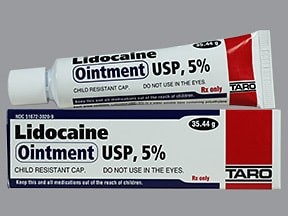
Contents
lidocaine – topical, Lidamantle, Xylocaine
Medication Uses How To Use Side Effects Precautions Drug Interactions Overdose Notes Missed Dose Storage USES: This medication is used on the skin to stop itching and pain from certain skin conditions (e.g., scrapes, minor burns, eczema, insect bites) and to treat minor discomfort and itching caused by hemorrhoids and certain other problems of the genital/anal area (e.g., anal fissures, itching around the vagina/rectum). Some forms of this medication are also used to decrease discomfort or pain during certain medical procedures/exams (e.g., sigmoidoscopy, cystoscopy). Lidocaine is a local anesthetic that works by causing temporary numbness/loss of feeling in the skin and mucous membranes. HOW TO USE: To use the cream, lotion, spray, foam, or gel on the skin, clean and dry the affected area as directed. Apply a thin layer of medication to the affected area of skin, usually 2 to 3 times a day or as directed.If you are using the spray, shake the canister well before using. While holding the canister 3-5 inches (8-13 centimeters) from the affected area, spray until wet. If the affected area is on the face, spray the medication onto your hand and apply to the face. Do not spray near your eyes, nose, or mouth.If you are using the foam, shake the canister well before using. Spray the foam onto your hand and apply to the affected area.Do not use on large areas of the body, cover the area with waterproof bandages or plastic, or apply heat unless directed to do so by your doctor. These may increase the risk of serious side effects.Wash hands immediately after use unless you are treating an area on the hands. Avoid getting the product in eyes, nose, or ears. If the medication gets in these areas, rinse the area immediately with clean water.Dosage is based on your medical condition and response to therapy. Do not use more of this product, use it more often, or keep using it longer than prescribed by your doctor. If you are using a nonprescription product, follow all the directions on the product package, or use as directed by your doctor. If there is an infection or sore in the area to be treated, do not use this medication without consulting your doctor first.Inform your doctor if your condition does not improve or worsens. SIDE EFFECTS: Temporary redness, stinging, and swelling may occur at the application site. If these effects persist or worsen, notify your doctor.Remember that your doctor has prescribed this medication because he or she has judged that the benefit to you is greater than the risk of side effects. Many people using this medication do not have serious side effects.Tell your doctor immediately if any of these rare but very serious side effects occur: slow/shallow breathing, slow/irregular heartbeat, seizures.A very serious allergic reaction to this drug is rare. However, seek immediate medical attention if you notice any of the following symptoms of a serious allergic reaction: new/worsening rash, new or worsening itching/swelling (especially of the face/tongue/throat), severe dizziness, trouble breathing.This is not a complete list of possible side effects. If you notice any other effects not listed above, contact your doctor or pharmacist.In the US -Call your doctor for medical advice about side effects. You may report side effects to FDA at 1-800-FDA-1088.In Canada – Call your doctor for medical advice about side effects. You may report side effects to Health Canada at 1-866-234-2345.
PRECAUTIONS: Before using lidocaine, tell your doctor or pharmacist if you are allergic to it; or to other amide type anesthetics (e.g., bupivacaine, prilocaine); or if you have any other allergies. This product may contain inactive ingredients, which can cause allergic reactions or other problems. Talk to your pharmacist for more details.Before using this medication, tell your doctor or pharmacist your medical history, especially of: broken skin/infection in the area where lidocaine is to be used, heart disease, liver disease.Caution is advised when using this drug in children because they may be more sensitive to the side effects of the drug.During pregnancy, this medication should be used only when clearly needed. Discuss the risks and benefits with your doctor.It is not known whether this drug passes into breast milk. Consult your doctor before breast-feeding. DRUG INTERACTIONS: Drug interactions may change how your medications work or increase your risk for serious side effects. This document does not contain all possible drug interactions. Keep a list of all the products you use (including prescription/nonprescription drugs and herbal products) and share it with your doctor and pharmacist. Do not start, stop, or change the dosage of any medicines without your doctor’s approval. OVERDOSE: This medicine may be harmful if inhaled or swallowed. If overdose, inhalation, or swallowing is suspected, contact a poison control center or emergency room immediately. US residents can call their local poison control center at 1-800-222-1222. Canada residents can call a provincial poison control center. Symptoms of overdose may include: drowsiness, irregular heartbeat, seizures. NOTES: Do not share this medication with others. MISSED DOSE: If you miss a dose, apply it as soon as you remember unless it is almost time for the next dose. In that case, skip the missed dose and resume your usual dosing schedule. Do not double the dose to catch up. STORAGE: Store at room temperature away from light and moisture. Do not freeze. Keep all medications away from children and pets.Do not store the gel or the foam or spray canisters near high heat (more than 120 degrees F/49 degrees C), and do not store or use it near open flame. Because the foam or spray canisters are under pressure, do not puncture or burn the container.Do not flush medications down the toilet or pour them into a drain unless instructed to do so. Properly discard this product when it is expired or no longer needed. Consult your pharmacist or local waste disposal company for more details about how to safely discard your product. Information last revised September 2013. Copyright(c) 2013 First Databank, Inc.
Related Disease Conditions
Hemorrhoids (Internal and External)
Hemorrhoids (piles) are swollen veins in the rectum and anus. Causes include pregnancy, obesity, diarrhea, low-fiber diet, and prolonged sitting on the toilet. Treatment varies depending upon the severity of the hemorrhoids. Some treatment options include over-the-counter creams and suppositories, stool softeners, warm sitz baths, and hemorrhoidectomies.
Cuts, Scrapes, and Puncture Wounds
Learn about first aid for cuts, scrapes (abrasions), and puncture wounds, when to see a doctor, if tetanus shots are necessary, and how to spot signs of infection.
Cold Sores (Oral Herpes, Herpes Labialis)
Cold sores (labial herpes) are caused by herpes simplex virus type 1 infection and often appear on the mouth and lips. Read about treatment causes, symptoms, treatment, and diagnosis of oral herpes.
Burns
Burn types are based on their severity: first-degree burns, second-degree burns, and third-degree burns. The damage is more severe with second-degree burns, leading to blistering and more intense pain. The skin turns white and loses sensation with third-degree burns. Burn treatment depends upon the burn location, total burn area, and intensity of the burn.
Natural Home Remedies for Sunburn
There are many natural and home remedies that are thought to relieve the symptoms and signs of a sunburn. Check out our top 30 tips to cool that sunburn, for example, drink lots of water, juice, or sports drinks; apply a cool compress containing Burow’s solution; coconut oil can be used as a moisturizer after sunburn pain has stopped; apply topical over-the-counter (OTC) 1% hydrocortisone cream; and take OTC pain relievers like NSAIDs (nonsteroidal anti-inflammatory drugs) such as ibuprofen (Advil, Motrin) or naproxen (Aleve).


